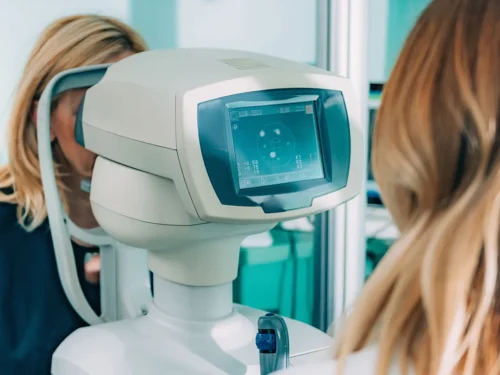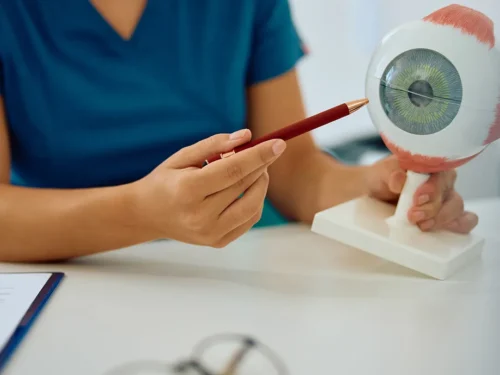
LASIK eye doctors in Los Angeles advise those who have diabetes to make sure they have their annual eye exam because it could save their sight. The Academy of Ophthalmology and the American Diabetes Association encourage everyone over 65 to have yearly eye exams.
Doctor Ferzaad Moosa, laser eye surgery doctor in Los Angeles tells us that Type 2 diabetes, also known as adult-onset diabetes, affects over 30.3 million Americans. This includes one-fourth of individuals over 65. Also, for those with diabetes, about a quarter don’t even know they have it and are blissfully ignorant of any threat of vision loss.
How Does Diabetes Deteriorate Eyesight?
The LASIK eye center doctor in Los Angeles lets us know that diabetes can harm the eyes, nerves, organs, and limbs because the body can’t effectively use insulin, a hormone secreted by the pancreas.
The pancreas and insulin are very important since they are responsible for the processing and shipping of blood glucose from your food to your body’s cells.
The LASIK eye expert in Los Angeles says that blood sugar serves as your primary energy source when everything is running smoothly. However, when you intake too many foods that spike your blood sugar or your pancreas starts to slow down, glucose just hangs out in your bloodstream instead of reaching your cells. When this process happens, it can spark vision loss and, eventually, blindness.
That is why it’s important to be diagnosed with diabetes as early as possible so you can get a better visual outcome. You always want to find changes to the eye before the damage is irreversible.
Diabetes affects the small blood vessels. For this reason, excess blood sugar destroys the body’s smallest blood vessels and restricts blood flow, which fasts the tissues’ capillary feed. As a result, there are leaking blood vessels, swelling, and other horrible complications.
Fluid leaks can change the shape and size of the eye’s lens, causing cataracts. Also, these leaks can destroy the retina, which is the back of the eye, where visual images are created.
Diabetes can generate hemorrhages (bleeding) and edema (excess fluid) in the retina that can seriously affect vision. The LASIK eye doctors in Los Angeles say that diabetic retinopathy is the fourth leading cause of blindness in the world.
When your eye bleeds or has retina detachment, it requires surgery, so don’t ask about LASIK eye surgery cost. Because if you don’t get eye surgery in time, severe vision may be permanent. Macular edema is swelling in the retina as it can happen at any stage of diabetes. Hungry capillaries also give rise to glaucoma, an eye disease that harms the optic nerve.
Eye Exams Are Important For Diabetics
Many diabetic patients do not experience visual symptoms. They could experience blurred or wavy vision or patches of lost sight without being aware that these are serious. If you are diabetic, it’s important to get your eye exams to find these conditions early before they cause permanent vision loss or blindness.
Don’t settle for just any visual exam. What you need is a complete comprehensive vision examination. Your eye doctor will dilate the eyes with drops so they can perform a thorough retinal exam.
Diabetic Retinopathy
Diabetic retinopathy is the most common diabetic eye disease. The condition happens after having long-term high blood sugar levels harm blood vessels in the retina, the light-sensing tissue that lines the back of the eye.
The first stage of diabetic retinopathy is called nonproliferative diabetic retinopathy. This happens when the blood vessels become blocked and start to cut off blood supply to the retina.
When the retina lacks sufficient blood supply, new, abnormal blood vessels start to proliferate (develop) in the retina. Unfortunately, these abnormal vessels can develop scar tissue and leak, which can cause a retinal detachment. Vision loss and various other eye diseases also can happen without early and proper treatment. This more advanced stage is referred to as proliferative diabetic retinopathy.
Although diabetic retinopathy only affects individuals with type 1 or type 2 diabetes, it is possible for someone who does not have diabetes to have retinopathy, another condition that arises from damage to the retina.
Macular Edema
Macular edema is directly linked to diabetic retinopathy and is a result of fluid from abnormal blood vessels that collect in the macula. The macula starts to swell and thicken as fluid gathers, which distorts eyesight. Important, detailed vision needed for driving and reading depends on the macula, making any related distortion a medical emergency.
Glaucoma
Glaucoma is defined by increased pressure within the eye. Leaking blood vessels caused by diabetic retinopathy can increase eye pressure and lead to neovascular glaucoma. As pressure carries on to build, the optic nerve may become damaged, and vision may be affected.
Retinal detachment
Diabetic retinopathy can cause the growth of scar tissue on retinal blood vessels. As more scar tissue develops, its weight can pull the retina away from its connective tissue. This development, known as retinal detachment, needs immediate medical attention, as it can lead to vision loss.
LASIK eye surgeons can help the median stages of diabetic eye disease with laser surgery and injections to the eyes to prevent retina’s swelling and abnormal blood vessels’ growth, known as neovascularization.
The American Academy of Ophthalmology reports that these types of injections can enhance vision in one-third of patients and stabilize the excess of capillaries in nine out of ten.
You can quickly check your blood sugars with an A1C blood test that measures the amount of sugar that sticks to hemoglobin molecules within the body’s cells.
If you have diabetes, make an appointment with Excel Laser Vision Institute in Los Angeles to discuss ways of treating and preventing eye conditions caused by diabetes.





